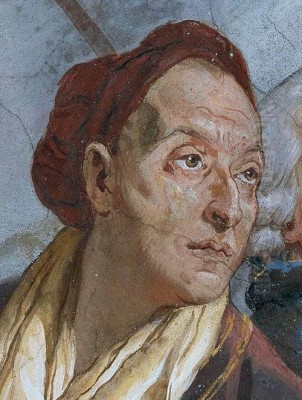
Giovanni Battista Tiepolo stands as one of the towering figures of 18th-century European art, the last in a long line of celebrated painters from the Venetian Republic. Born in Venice on March 5, 1696, and passing away in Madrid on March 27, 1770, his life spanned a period of significant artistic transition. Tiepolo mastered the grand tradition of Italian decorative painting, bringing the drama of the Baroque into the lighter, more airy realms of the Rococo. Renowned for his vast fresco cycles, luminous oil paintings, brilliant drawings, and imaginative etchings, Tiepolo's work adorned the palaces and churches of Italy, Germany, and Spain, leaving an indelible mark on the visual culture of his time. His ability to conjure vast, light-filled spaces populated by dynamic figures engaged in mythological, historical, or religious narratives cemented his reputation as arguably the greatest decorative painter of the era.
Venetian Beginnings: Family and Early Training
Giovanni Battista Tiepolo, often known simply as Giambattista, was born into a prosperous, though not artistically inclined, family in Venice. His father, Domenico Tiepolo, was a sea captain and merchant involved in maritime shipping. The family enjoyed a degree of social standing, indicated by Giovanni Battista's godfather being a Venetian nobleman. However, Domenico passed away when Giambattista was only a year old, leaving his mother, Orsetta, to raise him and his siblings. Despite the loss of the father, the family seems to have maintained a comfortable living standard, allowing the young Tiepolo to pursue an artistic path.
Around 1710, at the age of fourteen, Tiepolo entered the workshop of Gregorio Lazzarini, a respected and successful Venetian painter known for his eclectic style and solid craftsmanship. Lazzarini provided Tiepolo with a foundational education in drawing and painting techniques. While Lazzarini's own style was somewhat academic, his workshop was a prominent one, offering the young apprentice exposure to the bustling art scene of Venice. Tiepolo, however, was a precocious talent and quickly began to absorb influences beyond his master's studio.
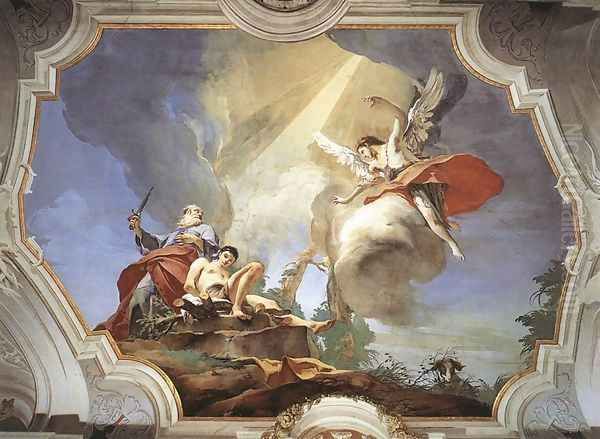
Even during his apprenticeship, Tiepolo looked towards other contemporary and past masters. He studied the dramatic chiaroscuro (strong contrasts of light and dark) favoured by painters like Giovanni Battista Piazzetta and the earlier Federico Bencovich. He also deeply admired the rich colour and grand compositions of the 16th-century Venetian Renaissance masters, particularly Paolo Veronese, whose opulent scenes and silvery light would become a lasting inspiration for Tiepolo's own large-scale decorative works. Sebastiano Ricci, another prominent Venetian history painter known for his lighter palette and fluid brushwork, also significantly impacted Tiepolo's developing style. By 1717, Tiepolo felt confident enough to leave Lazzarini's studio and work independently.
Launching a Career in Venice
Tiepolo's independent career began to take shape quickly. In 1719, he became a member of the Venetian Guild of Painters (the Fraglia dei Pittori), a necessary step for establishing himself professionally in the city. That same year, he married Maria Cecilia Guardi, the sister of fellow painters Francesco Guardi and Giovanni Antonio Guardi. This marriage connected him to another artistic family in Venice and produced a large family, including at least ten children, two of whom, Giovanni Domenico (Giandomenico) and Lorenzo, would become his pupils and lifelong collaborators.
His early works, such as The Sacrifice of Isaac (c. 1716), already showed a penchant for dramatic intensity and the use of contrasting light derived from Piazzetta and the tenebrist tradition. However, he soon began to move away from these darker tones towards a brighter, more luminous palette. Commissions started coming in, initially for religious paintings for Venetian churches and confraternities. He received praise for works displayed at the church of San Rocco as early as age twenty.
A significant early commission that marked his arrival as a major talent was the decoration of the Archbishop's Palace in Udine, undertaken between 1726 and 1729. Here, Tiepolo painted a series of frescoes depicting scenes from the Old Testament, demonstrating his growing mastery of large-scale narrative composition and his developing signature style characterized by bright, airy colours, dynamic figures, and a sense of theatrical grandeur. These frescoes established his reputation not just in Venice but in the wider Veneto region. Other notable works from this period include historical paintings like Scipio Africanus Freeing Massiva (c. 1719-1721) and allegorical pieces such as The Power of Eloquence (c. 1724-1725), showcasing his versatility across different genres.
The Master of Monumental Decoration
While Tiepolo produced numerous easel paintings throughout his career, his greatest fame rests on his monumental fresco decorations. He possessed an unparalleled ability to create vast, illusionistic spaces on ceilings and walls, seemingly opening them up to the heavens. His frescoes are characterized by their soaring perspectives (di sotto in sù – seen from below), luminous atmosphere, pastel colour schemes, and effortless integration of figures within complex architectural settings, whether real or painted.
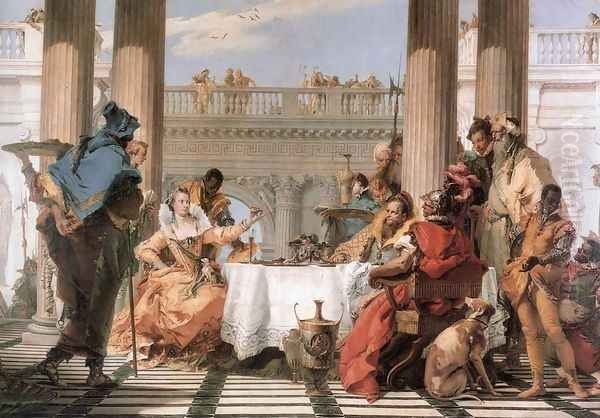
Throughout the 1730s and 1740s, Tiepolo received increasingly prestigious commissions in Venice and Northern Italy. He decorated numerous palaces for the Venetian nobility, including the Palazzo Labia (with scenes from the life of Cleopatra, including the famous Banquet of Cleopatra, c. 1743-44), the Palazzo Dugnani in Milan, and Ca' Rezzonico in Venice (home now to the Museum of 18th-century Venice). He also continued to work for ecclesiastical patrons, decorating churches like the Gesuati (Santa Maria del Rosario) in Venice with stunning ceiling frescoes depicting the Institution of the Rosary (1737-39).
His style during this period reached full maturity. He perfected his use of light and colour to create effects of dazzling brilliance and atmospheric depth. Figures seem to float effortlessly in light-filled skies, rendered with fluid brushwork and elegant poses. His compositions are often complex, featuring numerous figures arranged in dynamic, swirling patterns, yet they maintain a sense of clarity and harmony. He frequently employed allegory and mythology, drawing on classical texts and emblem books to create sophisticated visual narratives tailored to the tastes and aspirations of his patrons. His work embodied the spirit of the Rococo – elegant, playful, and visually delightful, yet executed with the technical virtuosity and compositional grandeur inherited from the Baroque tradition.
International Fame: Würzburg
Tiepolo's reputation extended far beyond Italy, attracting the attention of powerful patrons across Europe. His most significant international commission, and arguably the pinnacle of his career, came from Germany. In 1750, Prince-Bishop Carl Philipp von Greiffenclau zu Vollraths summoned Tiepolo to Würzburg to decorate his magnificent new Residenz, designed by the architect Balthasar Neumann. Tiepolo, accompanied by his sons Giandomenico and Lorenzo as assistants, spent three years (1750-1753) working on this vast project.
The Würzburg Residenz frescoes represent Tiepolo's genius on its grandest scale. Over the enormous vault of the main staircase (Treppenhaus), he painted an Allegory of the Planets and Continents. This breathtaking fresco, one of the largest in the world, depicts Apollo embarking on his daily course across the sky, surrounded by deities representing the planets, while allegorical figures representing the four known continents (Europe, Asia, Africa, and America) pay homage along the cornice. The work is a masterpiece of illusionism, seamlessly blending painted figures and architecture with the real space of the staircase, creating an overwhelming sense of light, space, and movement. Tiepolo included portraits of himself, his son Giandomenico, and Neumann among the figures.
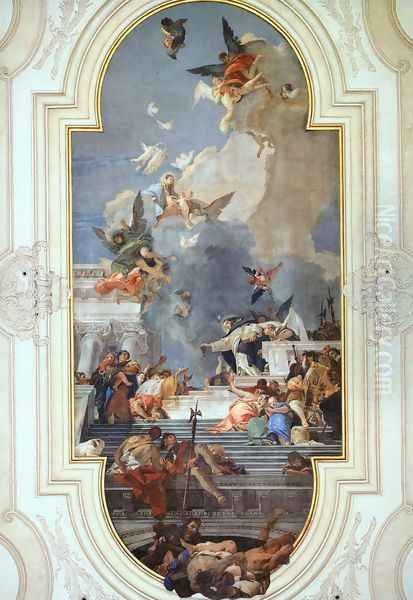
In the Imperial Hall (Kaisersaal), Tiepolo painted scenes celebrating the history of the Holy Roman Empire and the Bishopric of Würzburg, linking the Prince-Bishop to Emperor Frederick Barbarossa. Works here include Apollo Conducting Beatrice of Burgundy to the Emperor Frederick Barbarossa and The Investiture of Bishop Herold of Würzburg. These frescoes are characterized by their silvery light, pastel colours, and incredibly sophisticated compositions, perfectly complementing the ornate Rococo architecture and stucco work of the hall. The Würzburg frescoes cemented Tiepolo's status as the preeminent decorative painter in Europe.
The Spanish Years and Final Chapter
After returning to Venice from Würzburg, Tiepolo was celebrated as a hero. He was elected the first President of the Venetian Academy of Painting and Sculpture in 1755, a position he held until 1758. He continued to receive commissions in the Veneto region, including the decoration of the Villa Valmarana near Vicenza (with scenes from epic poetry, 1757) and the Palazzo Pisani Moretta in Venice. His sons, particularly Giandomenico, increasingly took on larger roles in the workshop, developing their own distinct styles while still working under their father's direction.
In 1761, Tiepolo received another major royal invitation, this time from King Charles III of Spain, to decorate the newly built Royal Palace in Madrid. At the age of 65, Tiepolo embarked on this final major journey, again accompanied by his sons Giandomenico and Lorenzo. He arrived in Madrid in 1762 and spent the remaining years of his life working primarily on ceilings for the vast palace.
His principal works in the Madrid Royal Palace include the immense ceiling fresco in the Throne Room, depicting The Apotheosis of Spain (or The Glory of Spain, 1764), and frescoes in the Saleta (antechamber) and the Guard Room. These works maintain the brilliance and grandeur of his earlier style, but some critics detect a slightly cooler palette and perhaps a concession to the emerging Neoclassical taste that was beginning to take hold in European courts.
The artistic environment in Madrid was different from Venice or Würzburg. Tiepolo faced rivalry from the influential Neoclassical painter Anton Raphael Mengs, a favourite of the King's advisor Johann Joachim Winckelmann. While Charles III continued to support Tiepolo, the changing artistic climate perhaps foreshadowed the decline in popularity his Rococo style would face after his death. Despite these undercurrents, Tiepolo continued working, also undertaking commissions for altarpieces for the church of San Pascual in Aranjuez (1767-69). These late religious works possess a profound spiritual intensity and a more sombre emotional depth compared to his celebratory frescoes. Giovanni Battista Tiepolo died suddenly in Madrid on March 27, 1770, at the age of 74.
Versatility: Oil Paintings, Drawings, and Etchings
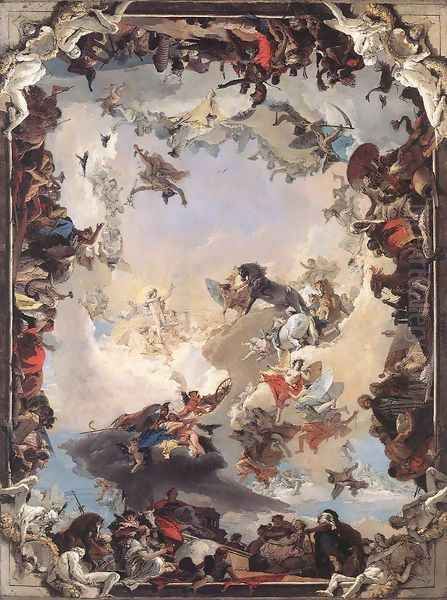
While renowned for frescoes, Tiepolo was also a prolific painter of works on canvas. These oil paintings covered a wide range of subjects, including religious scenes, mythological narratives, historical episodes, and portraits. Notable examples include The Banquet of Cleopatra (versions exist, e.g., National Gallery of Victoria, Melbourne), Jupiter and Danaë (Universitetets Konsthistoriska Institutionen, Stockholm), The Martyrdom of St. Bartholomew (various versions), and late works like the Madonna of the Goldfinch (National Gallery of Art, Washington D.C.). These paintings display the same characteristics as his frescoes: luminous colour, dynamic composition, and elegant figures, though often with a greater degree of finish and detail appropriate to the smaller scale.
Tiepolo was also one of the most brilliant draughtsmen of the 18th century. Thousands of his drawings survive, executed primarily in pen and brown ink wash over preliminary sketches in black or red chalk. These drawings served various purposes: preparatory studies for figures or compositions in his paintings and frescoes (modelli), rapid sketches capturing initial ideas (primi pensieri), and finished drawings intended as works of art in their own right. His drawings are prized for their spontaneity, fluidity of line, and masterful use of wash to create effects of light and shadow. They reveal the fertility of his imagination and the confidence of his hand. Collections of his drawings are held in major museums worldwide, including the Metropolitan Museum of Art, the Victoria and Albert Museum, and the Morgan Library & Museum.
Furthermore, Tiepolo was a highly original etcher. He produced two main series of etchings: the Capricci (c. 1743) and the Scherzi di Fantasia (c. 1743-1757). These prints are not illustrations of specific texts but rather imaginative, often enigmatic scenes featuring soldiers, magicians, satyrs, philosophers, and exotic figures in dreamlike landscapes strewn with ancient ruins, urns, and obelisks. They showcase Tiepolo's inventive genius and his technical skill in etching, particularly his ability to create rich tonal variations and atmospheric effects. These works influenced later printmakers, including Francisco Goya, who admired Tiepolo's imaginative freedom.
Style, Technique, and Influences Summarized
Giovanni Battista Tiepolo's art represents the culmination of the Venetian tradition of grand decorative painting, infused with the lightness and elegance of the international Rococo style. His signature characteristics include:
1. Luminous Color Palette: Moving away from the dark shadows of the early Baroque, Tiepolo embraced a high-keyed, airy palette dominated by pastel blues, pinks, yellows, and silvery whites, creating an effect of brilliant, sun-drenched light.
2. Dynamic Composition: His compositions, especially in frescoes, are typically complex and full of movement, often using diagonal lines and swirling vortexes of figures to draw the viewer's eye upwards.
3. Mastery of Perspective: He excelled at illusionistic perspective, particularly the di sotto in sù technique, making ceilings appear to open into vast celestial realms.
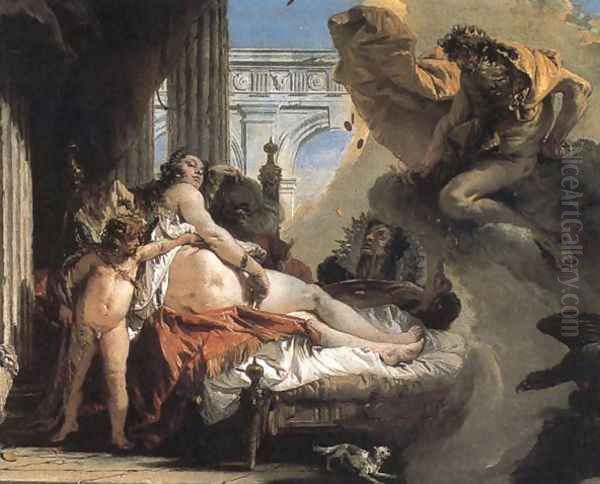
4. Fluid Brushwork: His brushwork is typically free and energetic, defining forms with calligraphic elegance rather than tight precision, contributing to the overall sense of lightness and movement.
5. Theatricality and Spectacle: His works often have a stage-like quality, presenting historical, mythological, or religious events as grand, dramatic spectacles.
6. Synthesis of Influences: He masterfully blended the grandeur and colour of Paolo Veronese, the dramatic intensity of earlier Baroque artists like Piazzetta, and the lighter touch of contemporaries like Sebastiano Ricci, forging a unique and highly personal style.
Contemporaries, Collaborators, and Legacy
Tiepolo operated within a vibrant Venetian art world. His contemporaries included the veduta (view) painters Canaletto and Francesco Guardi (his brother-in-law), the pastel portraitist Rosalba Carriera, and his early influence, Giovanni Battista Piazzetta. While Canaletto focused on detailed cityscapes primarily for the tourist market, Tiepolo dominated the field of large-scale decorative commissions for local and international patrons. His relationship with his sons, Giandomenico and Lorenzo, was primarily collaborative. They worked alongside him in his workshop, assisting on major projects like Würzburg and Madrid. Giandomenico, in particular, became a significant artist in his own right, known for his genre scenes and etchings, carrying on the family workshop after his father's death, though his style evolved towards a more realistic and sometimes satirical vein. Other documented pupils included Fabio Canal, Francesco Lorenzi, and Domenico Pasquini.
In Madrid, his main rival was the German Neoclassicist Anton Raphael Mengs. Their contrasting styles represented the shift occurring in European art: Tiepolo embodying the final flowering of the Baroque-Rococo tradition, while Mengs championed the new ideals of clarity, order, and classical restraint that would dominate the later 18th century.
Despite the temporary eclipse of his reputation during the Neoclassical era, Tiepolo's genius was rediscovered and celebrated from the late 19th century onwards. Artists like the French Impressionists admired his light-filled canvases, and later generations recognized the sheer brilliance of his technique and the boundless fertility of his imagination. He is now universally acknowledged as the greatest Italian painter of the 18th century and one of the supreme masters of monumental decoration in Western art. His influence can be seen in the work of later artists, including Francisco Goya in Spain.
Major Collections and Enduring Presence
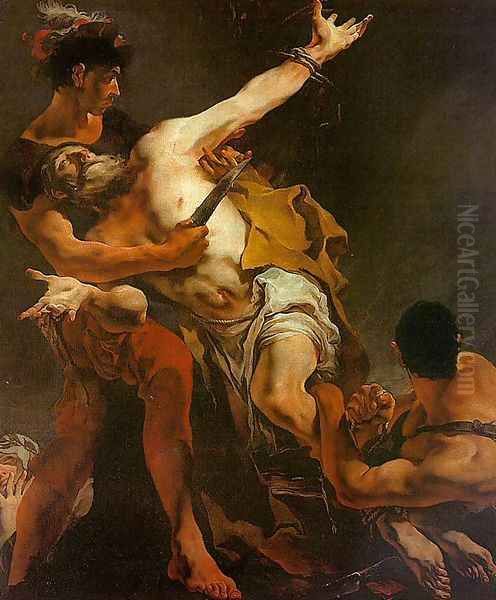
Works by Giovanni Battista Tiepolo are held in major museums and collections across the globe, as well as remaining in situ in the palaces and churches they were created for. Key institutions include:
Gallerie dell'Accademia, Venice: Holds a significant collection of his oil paintings and drawings.
Ca' Rezzonico (Museum of 18th Century Venice): Features frescoed ceilings by Tiepolo.
Würzburg Residenz, Germany: Home to his most famous fresco cycle.
Alte Pinakothek, Munich: Possesses important altarpieces and oil paintings.
Palacio Real, Madrid: Contains his late ceiling frescoes.
Museo del Prado, Madrid: Holds oil sketches and paintings, including altarpieces originally from Aranjuez.
Metropolitan Museum of Art, New York: Owns a rich collection of paintings, drawings (including the Scherzi and Capricci etchings), and oil sketches like those for the Palazzo Clerici in Milan.
National Gallery, London: Features several important oil paintings, including works from the Palazzo Labia cycle.
National Gallery of Art, Washington D.C.: Holds paintings like the Madonna of the Goldfinch.
Victoria and Albert Museum, London: Possesses a large collection of his drawings.
J. Paul Getty Museum, Los Angeles: Collects his drawings and paintings.
The Louvre, Paris: Houses paintings and drawings.
Diocesan Museum, Udine: Displays works related to his early frescoes there.
Numerous exhibitions continue to explore his work, such as those held recently in Frankfurt ("Tiepolo – Venice in the North," 2021) and Helsinki (Sinebrychoff Art Museum), demonstrating the enduring interest in his art.
Conclusion: The Last Great Venetian Master
Giovanni Battista Tiepolo represents the glorious culmination of centuries of Venetian painting. He inherited the rich traditions of colour, light, and grand composition from predecessors like Titian and Veronese, adapting them to the tastes and sensibilities of the 18th century. His art combines Baroque drama with Rococo elegance, creating spectacular visual experiences that are both intellectually engaging and aesthetically delightful. Whether soaring across vast ceilings in luminous frescoes, capturing mythological drama on canvas, or unleashing his imagination in spontaneous drawings and etchings, Tiepolo worked with unparalleled virtuosity and imaginative power. He remains a pivotal figure in European art history, the last truly great exponent of the Italian tradition of monumental decorative painting, leaving behind a legacy of breathtaking beauty and spectacle.